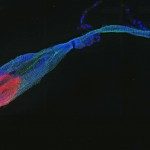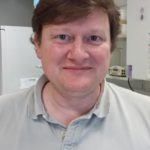Link to Pubmed [PMID] – 11283094
J. Clin. Microbiol. 2001 Apr;39(4):1595-9
Based on the variability of 43 spacers within the direct repeat (DR) locus of Mycobacterium tuberculosis complex organisms, spoligotyping is a rapid method that aids in the study of the epidemiology of tuberculosis. It was recently hypothesized that despite its presence in the DR locus, spacer 31 could not be amplified in M. tuberculosis clinical isolates belonging to spoligotype 50 due to the insertion of an extra copy of IS6110 between spacers 31 and 32 that could lead to an asymmetrical split of the primer targets (I. Filliol, C. Sola, and N. Rastogi, J. Clin. Microbiol. 38:1231–1234, 2000). In the present investigation, previous observations were extended to 25 clinical isolates of type 50 showing that the primer set IS6-DRb that selectively amplified the left and central DR regions was indeed able to demonstrate the presence of spacer 31. IS6110-restriction fragment length polymorphism (RFLP) and DR-RFLP showed that type 50 isolates were characterized by the presence of two copies of IS6110 associated with the DR locus and an additional double IS6110 band of 1.4 kb. The primer set IS3-IS6 was then used to selectively amplify a 750-bp inter-IS6110 fragment within the DR locus. The sequencing of the central DR region corroborated our previous findings and showed that the absence of spacer 31 among the type 50 isolates was due to the asymmetric insertion of an extra copy of IS6110 between spacers 31 and 32, leading to an unequal split of the DRa-DRb target into two portions, of 6 and 30 bp, respectively. These results show that the DR locus constitutes an ideal IS6110 preferential locus (ipl), permitting the insertion of two or more copies of IS6110, and provide new clues for epidemiological and phylogenetic interpretation of changes in IS6110-RFLP and spoligotyping profiles.

